
Wine Culture and Information since 2002 - Volume 22
 Wine Culture and Information since 2002 - Volume 22 |
|
Issue 154, September 2016 |
Contents |
|
|
The Time of Wine |
|
Wine gets better over time. How many times we said, of heard saying, something or someone is like a good wine and gets better over time? This probably is one of the most well known saying of Italy. A wine gets better over time, well, not all the time. It is however undeniable there are wines that, over time, reach extraordinary peaks of excellency, likewise it also true some of them - just after few years - get inexorably worse. Time is a well known relative concept and this is certainly true for wine too, each wine, territory, area, grape, vintage and interpretation of man. We cannot in fact define the age of a wine, like to say, in absolute terms, as this measure changes according to the characteristics and limits of the wine itself. We can however be sure the measure of time, better to say, longevity of wine, can be prolonged according to proper and specific viticultural and wine making techniques. A wine, in order to challenge time and get better over the course of years, must be produced with this specific goal in mind. These wines, in fact, are made with the awareness that, in order to properly enjoy the result of the work in the vineyard and of vintner, one needs to wait some years. The wait is frequently worth the time, provided the keeping of wine has been properly done and with care. Tasting a wine destined to a long aging just after few months, means to face a huge disappointment. In the glass we will get, in this case, a wine lacking in harmony and balance, with an evident excess caused by particular gustatory stimuli, most of the time being more than one. The classic example is offered by red wines produced with the goal of giving their best over time: the astringency of tannins can be so aggressive and fierce as to taste unpleasing. Something producers know very well when they need to taste their young wines straight from the cask or barrique. I admit - and I know I am not alone here - when in the glass I have a wine magnificently embellished by time, the enchantment in each sip, sight and aroma, is something getting my whole attention. It is impossible not to be caught in those endless nuances only time can give to wines capable of catching them in order to make a magic out of them. Time is in fact capable of setting up a magnificent stage where color, aromas and taste of wine play a majestic part for the senses, privileged spectators of an unrepeatable show. The actors on the stage are not always capable of playing such a noble role, however, in case they are, ladies and gentlemen, all we can do is bowing to the wine with reverence. A bow to the wine - of course - as well as to those who made it and let it live, by taking its hand from vineyard to glass. The beauty of the show, there is no doubt about this, also depends on personal tastes and it may happen some cannot appreciate or understand what time gave to wine - that wine - to that bottle. What amazes me quite a lot is when those “shows” are played by white wines, in particular for the fact, according to many, these wines should be consumed within two years from harvesting. They should change their mind because - in my opinion - they do not really know what they are missing in uncorking certain whites after few years from harvesting. Consumers - better to say, most of consumers - are always looking for white wines of the latest vintage, in particular in restaurants, virtually after few months from harvesting. Restaurateurs too are responsible for this, most of the times incapable of properly suggesting wines to their clients, they just do what can satisfy their requests: when the clients are happy, everyone is happy. This forces producers - who are evidently responsible in this nonetheless - to sell their wines as soon as possible, indeed, to make them with the goal of having them ready after few months from harvesting. The few and enlightened restaurateurs who suggest to their clients a white wine worth to be enjoyed after some years from harvesting, are sometimes accused of being unfair for the fact they are trying to sell an old wine. On the contrary, it is easy to serve at a table a red wine having some years of age, indeed, in this case consumers seem to appreciate the suggestion just because “wine gets better over time”. This is true, of course, provided the wine is red and, even better, important. And who knows what does exactly “important wine” mean? Those who wish to pour in their glasses a white wine at the restaurant, ask for young bottles, very young, virtually a wine which has just been racked from the cask. The exception is in case it is a white wine aged in cask or in barrique, in this case they can make an exception. A vicious circle, unfortunately, forcing restaurateurs to buy young white wines and producers who, in order to sell their wine, do everything in order to make them happy. This happens because they do not have the will to make proper decisions and to sell their wines when they are ready to drink, by telling restaurateurs they are going to sell the wine only when the bottle is ready to give its best. There is another style of wine I love to uncork after some time spent to “meditate” in the bottle and here, this is quite likely, I am afraid there are few to be with me in this: classic method sparkling wines. Bubbles refermented in bottle and with some years of aging after disgorgement, becomes monuments of extraordinary sensorial complexity, magnificent interpreters of time. They get an elegant roundness capable of supporting effervescence and acidity that - despite the time going by - are however alive and stingy. Aromas are wearing noble clothes, just like precious brocade, giving an endless wonder and pleasure to the nose. The art of keeping of course plays a very important role - last but not the least, the role of the one who made it - and can become a discriminating factor between the apotheosis and the worst disappointment. For sure, when I see in my cellar a white or classic method sparkling wine which benefited from the evolution of time, I take my corkscrew and I get ready to enjoy the show. And I think about those who, unlucky them, have uncorked that very same bottle few years in advance, my face has a sly and satisfied smile because they will never know what they missed. Antonello Biancalana
|
||||
Contrasts of Frappato and Refosco dal Peduncolo RossoSicily and Friuli Venezia Giulia compared by evaluating two of the most significant and famous red berried grapes of their respective regions. |
|
This month, just like what we did other times, we will examine two geographically distant grapes, protagonists in their respective regions and precisely Sicily and Friuli Venezia Giulia. In the tasting by contrast of this month we will in fact pour in our glasses wines produced with Frappato - to represent Sicily - and Refosco dal Peduncolo Rosso, prestigious variety of Friuli Venezia Giulia. Two very different grapes, not only because of the geographical distance dividing them, but in particular for their viticultural and enological qualities, giving to the glass distant wines as well. Varieties of remarkable personality, Frappato and Refosco dal Peduncolo Rosso are vinified both alone and blended to other grapes and, in this specific case, their contribution is frequently recognizable and determinant. Protagonists in wines belonging to Italian Denominazione d'Origine Controllata, Frappato and Refosco dal Peduncolo Rosso are today among the most representative grapes in their respective regions. Two different characters, something evident by simply evaluating the aspect, wines produced with Frappato and Refosco dal Peduncolo Rosso are different on every aspect and this is particularly evident in the taste. Both varieties are getting more and more popular in the last recent years, in particular Frappato, the queen grape of the territory of Vittoria, in province of Ragusa, and its renowned Cerasuolo. Talking about popularity, Refosco dal Peduncolo Rosso is nothing less than the Sicilian variety, as it is the important protagonist of reds in Friuli Venezia Giulia and it is a grape used for the production of many Denominazione d'Origine Controllata wines. The spreading of the two grapes is practically limited to their respective regions of origin, although it should be noticed Refosco dal Peduncolo Rosso is marginally found in other regions as well, in particular Veneto.
|
|
Frappato is one of the great red grapes found in vineyards of Sicily, famous, in particular, for being the protagonist of Denominazione d'Origine Controllata “Vittoria Frappato” and part of the only DOCG wine of the island. This interesting red variety is in fact used, with Nero d'Avola, for the production of Cerasuolo di Vittoria and it can also be present up to 50%. Frappato, despite it is mainly cultivated in the provinces of Ragusa and Syracuse, it is also found in the whole territory of Sicily and its origin is not completely clear. Frappato is believed by some to be an indigenous variety of Sicily, whereas others support the idea it was introduced to this island from the Iberian Peninsula, although it is not clear how this may have happened. A research done on Frappato's DNA suggested this variety has analogies with Sangiovese, however it should be noticed the wines produced with the Sicilian variety are completely different. Another theory suggests Frappato may have a connection to Ciliegiolo, as well as to Gaglioppo, the famous red grape from Calabria. Even the origin of the name seems to be unclear. Some believe Frappato comes from the term fruttato (Italian for fruity) as the wines produced with this grape give to the nose intense sensations directly recalling red and black fruits. The only sure thing about this grape is the first mention of Frappato: in a document dated back to the half of 1700s and found in Vittoria - in province of Ragusa - we can in fact read this variety was already cultivated in this territory at those times. Wines produced with Frappato are characterized by a color of moderate transparency, with aromas having a strong fruity character in which - sometimes - can also be perceived spicy notes, in particular black pepper. Capable of giving wines with a good body, Frappato is also characterized by a pleasing crispness and moderate astringency.
|
||||
|
One of the most famous and significant red berried grapes of Friuli Venezia Giulia is, undoubtedly, Refosco dal Peduncolo Rosso. Found in the entire territory of Friuli Venezia Giulia, this renowned red grape is protagonist in many wines of the region, both used alone and blended to other varieties. Grape having a great personality, the contribution of Refosco dal Peduncolo Rosso in other wines does not pass unnoticed. This grape is the main representative of the so called “Refoschi” family, however it should be noticed it does not have any connection with the other members. The origin of this red grape is to be traced back to the Istrya and Karst regions and it was certainly known since the times of ancient Romans. The grape Romans called Pacium was, very likely, Refosco dal Peduncolo Rosso, which wines were very successful and appreciated. A research conducted on this variety allowed to discover some common qualities, among the many, with Corvina, Primitivo and Pinot Noir grapes. It must however be said wines produced with Refosco dal Peduncolo Rosso are, from an organoleptic point of view, quite different from those made with these varieties. Refosco dal Peduncolo Rosso is spread and found in the entire territory of Friuli Venezia Giulia, marginally found in the neighboring Veneto region as well. The name of this famous variety from Friuli comes from the typical red color the peduncle gets when the grape reaches full ripeness, a condition that - it should be said - it gets later than other varieties found in the area. Wines produced with Refosco dal Peduncolo Rosso are characterized by a good body - it is in fact frequently made in cask or barrique - and it also gives to the mouth a pleasing sensation recalling almond. A versatile grape and having character, Refosco dal Peduncolo Rosso is capable of making wines suited for the long aging and giving - over time - interpretations of remarkable value.
|
|
As usual, for our tasting by contrast we will choose two wines produced with the grapes protagonists of the evaluation and used alone, in order to ensure the best expression of the respective characteristics. As this is something usually happening with mono varietal Italian wines belonging to certain Denominazione d'Origine Controllata areas, despite in the label is mentioned the name of the variety, indeed it can represent the blend for a minimum of 85%. The remaining part is represented by other varieties provided by the denomination itself and that, most of the times, significantly affect the organoleptic profile of the main variety. We will make therefore sure to choose a Vittoria Frappato and a Colli Orientali del Friuli Refosco dal Peduncolo Rosso produced with 100% of the respective grapes and preferably vinified in inert containers, having about two years of aging. The wines, as usual, will be poured in their respective tasting glasses at the temperature of 18 °C (64 °F).
After having poured the two wines in their respective glasses, let's start the tasting by contrast from the appearance analysis, that is the characteristics of the wine perceived by the sight. The first wine we will evaluate is Vittoria Frappato and, by tilting the glass on a white surface, let's pay our attention to the base of the wine. Frappato gives the sight a brilliant and lively ruby red color with a moderate transparency from which can be seen the object behind the glass. Towards the opening of the glass, where the wine's thickness is at its thinnest, we will observe nuances in which can be clearly seen ruby red and, sometimes, purple hues. Let's now pass to the evaluation of Colli Orientali del Friuli Refosco dal Peduncolo Rosso and observe the base of the wine, by holding the glass tilted. The first difference to be noticed is transparency, evidently lower in the wine from Friuli. The color shows an intense and deep ruby red hue and, towards the opening of the glass, nuances confirm this color. The differences between the two varieties - evident and clear - will be revealed from the olfactory analysis of the wines, confirming the distance between the grapes and not only from a geographical point of view. Frappato is mainly appreciated for its lively and immediate aromas recalling red fruits, such as cherry, raspberry and strawberry. A characteristic frequently perceived in the Sicilian red is a pleasing spicy aroma recalling black pepper, a quality adding elegance and complexity to the wine. The olfactory profile of Refosco dal Peduncolo Rosso is quite different, in which we mainly perceive aromas of black fruits. In wine produced with this grape will be mainly perceived aromas of black cherry, plum, blueberry and blackberry, as well as a pleasing note of violet. The grape from Friuli is characterized, sometimes, by herbaceous sensations recalling vegetables, among the many, in particular, it can be perceived the aroma of bell pepper as well as a pleasing spicy aroma recalling black pepper. Just like what we did for the appearance analysis, also in olfactory evaluation we will start from Vittoria Frappato. Let's keep the glass in vertical position and, without swirling, evaluate opening aromas. From the glass are perceived intense and pleasing aromas of cherry, raspberry and strawberry, to which are added aromas of violet and cyclamen. After having swirled the glass, the olfactory profile of Frappato is completed by blueberry, plum, blackberry and, sometimes, it also reveals to the nose an aroma of black pepper. let's now pass to the olfactory evaluation of Colli Orientali del Friuli Refosco dal Peduncolo Rosso. The opening of this wine gives the nose aromas of black cherry, plum and blackberry - evidently “thicker” than Frappato - to which is added the aroma of violet. After having swirled the glass, the profile of this wine is completed by the aromas of blueberry, raspberry and cyclamen. In Refosco dal Peduncolo Rosso can be sometimes perceived aromas recalling the world of vegetables and herbs, in which can be sometimes recognized the aroma of green bell pepper. Let's now pass to the evaluation of the gustatory profiles of the two wines of our tasting by contrast, from which will be revealed substantial sensorial differences. Let's now take a sip of Vittoria Frappato and let's start the gustatory analysis. In the mouth Frappato has a pleasing crisp attack to which follows a good body, with a moderate transparency, however essential for its balance. In the mouth are perceived pleasing flavors of cherry, raspberry and strawberry, confirming what we already perceived to the nose. Let's now pass to Colli Orientali del Friuli Refosco dal Peduncolo Rosso and take a sip of this wine. The attack reveals a wine having a fuller body than Frappato, a lower crispness and a more evident astringent sensation, however moderate and right in order to get a good balance. In the mouth are perceived flavors of black cherry, plum and blackberry, a good correspondence to the nose. In both cases the contribution of alcohol is significant and well perceptible, non excessive, perfect for the gustatory balance. The final phase of our tasting by contrast will focus on the evaluation of taste-olfactory persistence of the two wines as well as the organoleptic sensations perceived in the mouth. The finish of Vittoria Frappato is of good persistence and in the mouth is possible to perceive - clean and intense - the aromas of cherry, raspberry and strawberry, confirming the qualities perceived both to the nose and taste. The finish of Colli Orientali del Friuli Refosco dal Peduncolo Rosso is persistent and, after having swallowed the wine, in the mouth are perceived intense flavors of black cherry, plum and blackberry, frequently followed by a sensation of bitter almond. Let's now compare the sensation of body and crispness left in the mouth by the two wines: Frappato is crisper than Refosco dal Peduncolo Rosso and with a weaker body. Two different and distant styles, however elegant and of extraordinary gustatory finesse, Frappato and Refosco dal Peduncolo Rosso makes wines having distinct characters, however of remarkable personality.
|
||||||||
Wines of the Month |
|
|
|
Score legend Prices are to be considered as indicative. Prices may vary according to the country or the shop where wines are bought |
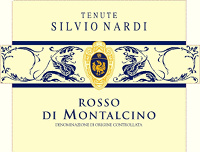
|
|
Rosso di Montalcino 2014 |
|
| Tenute Silvio Nardi (Tuscany, Italy) | |
 Sangiovese Sangiovese | |
| Price: € 14.00 | Score: |
 Brilliant ruby red and nuances of ruby red, moderate transparency. Brilliant ruby red and nuances of ruby red, moderate transparency. Intense, clean, pleasing and refined, starts with hints of black
cherry, plum and raspberry followed by aromas of violet, blueberry,
geranium, vanilla and carob. Intense, clean, pleasing and refined, starts with hints of black
cherry, plum and raspberry followed by aromas of violet, blueberry,
geranium, vanilla and carob.
 Properly tannic attack and however balanced by alcohol, good body,
intense flavors, pleasing crispness. Properly tannic attack and however balanced by alcohol, good body,
intense flavors, pleasing crispness.
 Persistent finish with flavors of black cherry, plum and raspberry. Persistent finish with flavors of black cherry, plum and raspberry. 12 months in cask. 12 months in cask. |
|
 Broiled meat and barbecue, Stewed meat with mushrooms, Hard cheese Broiled meat and barbecue, Stewed meat with mushrooms, Hard cheese |
|
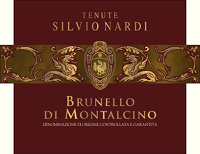
|
|
Brunello di Montalcino 2011 |
|
| Tenute Silvio Nardi (Tuscany, Italy) | |
 Sangiovese Sangiovese | |
| Price: € 130.00 | Score: |
 Brilliant ruby red and nuances of garnet red, moderate transparency. Brilliant ruby red and nuances of garnet red, moderate transparency. Intense, clean, pleasing and refined, starts with hints of black
cherry, plum and dried violet followed by aromas of raspberry, vanilla,
cinnamon, dried rose, tobacco, chocolate, mace and menthol. Intense, clean, pleasing and refined, starts with hints of black
cherry, plum and dried violet followed by aromas of raspberry, vanilla,
cinnamon, dried rose, tobacco, chocolate, mace and menthol.
 Tannic attack and however balanced by alcohol, full body, intense
flavors, pleasing roundness. Tannic attack and however balanced by alcohol, full body, intense
flavors, pleasing roundness.
 Persistent finish with flavors of black cherry, plum and raspberry. Persistent finish with flavors of black cherry, plum and raspberry. 12 months in barrique, 12 months in cask, 6 months in bottle. 12 months in barrique, 12 months in cask, 6 months in bottle. |
|
 Game, Roasted meat, Stewed and braised meat, Hard cheese Game, Roasted meat, Stewed and braised meat, Hard cheese |
|
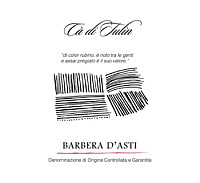
|
|
Barbera d'Asti 2010 |
|
| Cà di Tulin (Piedmont, Italy) | |
 Barbera Barbera | |
| Price: € 10.00 | Score: |
 Brilliant ruby red and nuances of garnet red, moderate transparency. Brilliant ruby red and nuances of garnet red, moderate transparency. Intense, clean and pleasing, starts with hints of cherry, prune and
dried violet followed by aromas of raspberry jam, strawberry jam, cyclamen
and blueberry. Intense, clean and pleasing, starts with hints of cherry, prune and
dried violet followed by aromas of raspberry jam, strawberry jam, cyclamen
and blueberry.
 Properly tannic attack and however balanced by alcohol, good body,
intense flavors, agreeable. Properly tannic attack and however balanced by alcohol, good body,
intense flavors, agreeable.
 Persistent finish with flavors of cherry, prune and raspberry jam. Persistent finish with flavors of cherry, prune and raspberry jam. 18 months in steel tanks, 4 months in bottle. 18 months in steel tanks, 4 months in bottle. |
|
 Cold cuts, Pasta with meat, Sauteed meat, Stuffed pasta Cold cuts, Pasta with meat, Sauteed meat, Stuffed pasta |
|
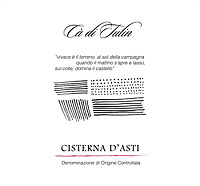
|
|
Cisterna d'Asti 2012 |
|
| Cà di Tulin (Piedmont, Italy) | |
 Croatina Croatina | |
| Price: € 12.00 | Score: |
 Intense ruby red and nuances of garnet red, little transparency. Intense ruby red and nuances of garnet red, little transparency. Intense, clean, pleasing and refined, starts with hints of black
cherry, blackberry and blueberry followed by aromas of raspberry, violet,
plum and cyclamen. Intense, clean, pleasing and refined, starts with hints of black
cherry, blackberry and blueberry followed by aromas of raspberry, violet,
plum and cyclamen.
 Properly tannic attack and however balanced by alcohol, good body,
intense flavors, pleasing roundness. Properly tannic attack and however balanced by alcohol, good body,
intense flavors, pleasing roundness.
 Persistent finish with flavors of black cherry, blackberry and
blueberry. Persistent finish with flavors of black cherry, blackberry and
blueberry.
 18 months in steel tanks, 4 months in bottle. 18 months in steel tanks, 4 months in bottle. |
|
 Cold cuts, Pasta with meat, Stewed meat, Roasted white meat Cold cuts, Pasta with meat, Stewed meat, Roasted white meat |
|
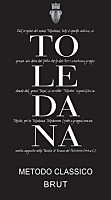
|
|
Toledana Metodo Classico Brut |
|
| La Toledana (Piedmont, Italy) | |
 Cortese (90%), Other Grapes (10%) Cortese (90%), Other Grapes (10%) | |
| Price: € 17.70 | Score: |
 Pale straw yellow and nuances of greenish yellow, very transparent,
fine and persistent perlage. Pale straw yellow and nuances of greenish yellow, very transparent,
fine and persistent perlage.
 Intense, clean and pleasing, starts with hints of apple, pear and bread
crust followed by aromas of hawthorn, plum, pineapple, chamomile and citrus
fruits. Intense, clean and pleasing, starts with hints of apple, pear and bread
crust followed by aromas of hawthorn, plum, pineapple, chamomile and citrus
fruits.
 Crisp and effervescent attack, however balanced by alcohol, good body,
intense flavors. Crisp and effervescent attack, however balanced by alcohol, good body,
intense flavors.
 Persistent finish with flavors of apple, pear and pineapple. Persistent finish with flavors of apple, pear and pineapple. Part of the base wine is fermented in barrique. Refermented in bottle
on its lees for at least 36 months. Part of the base wine is fermented in barrique. Refermented in bottle
on its lees for at least 36 months.
|
|
 Aperitifs, Risotto with vegetables, Sauteed fish, Dairy products, Eggs Aperitifs, Risotto with vegetables, Sauteed fish, Dairy products, Eggs |
|
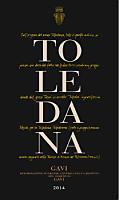
|
|
Gavi di Gavi 2014 |
|
| La Toledana (Piedmont, Italy) | |
 Cortese Cortese | |
| Price: € 13.40 | Score: |
 Brilliant straw yellow and nuances of straw yellow, very transparent. Brilliant straw yellow and nuances of straw yellow, very transparent. Intense, clean, pleasing and refined, starts with hints of apple,
citrus fruits and hawthorn followed by aromas of pear, plum, almond and
peach. Intense, clean, pleasing and refined, starts with hints of apple,
citrus fruits and hawthorn followed by aromas of pear, plum, almond and
peach.
 Crisp attack and however balanced by alcohol, good body, intense
flavors, pleasing roundness. Crisp attack and however balanced by alcohol, good body, intense
flavors, pleasing roundness.
 Persistent finish with flavors of apple, plum and almond. Persistent finish with flavors of apple, plum and almond. 6 months of aging in steel tanks. 6 months of aging in steel tanks. |
|
 Pasta with fish, Broiled fish, Sauteed white meat, Dairy products Pasta with fish, Broiled fish, Sauteed white meat, Dairy products |
|
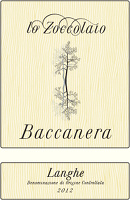
|
|
Langhe Rosso Baccanera 2012 |
|
| Lo Zoccolaio (Piedmont, Italy) | |
 Barbera, Merlot, Nebbiolo, Cabernet Sauvignon Barbera, Merlot, Nebbiolo, Cabernet Sauvignon | |
| Price: € 15.80 | Score: |
 Intense ruby red and nuances of garnet red, little transparency. Intense ruby red and nuances of garnet red, little transparency. Intense, clean, pleasing and refined, starts with hints of black
cherry, plum and black currant followed by aromas of violet, blueberry,
vanilla, chocolate and tobacco. Intense, clean, pleasing and refined, starts with hints of black
cherry, plum and black currant followed by aromas of violet, blueberry,
vanilla, chocolate and tobacco.
 Properly tannic attack and however balanced by alcohol, good body,
intense flavors, pleasing roundness. Properly tannic attack and however balanced by alcohol, good body,
intense flavors, pleasing roundness.
 Persistent finish with flavors of black cherry, plum and black currant. Persistent finish with flavors of black cherry, plum and black currant. 18 months in barrique. 18 months in barrique. |
|
 Stuffed pasta, Stewed meat, Roasted meat, Broiled meat and barbecue Stuffed pasta, Stewed meat, Roasted meat, Broiled meat and barbecue |
|
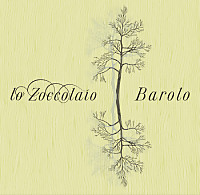
|
|
Barolo 2010 |
|
| Lo Zoccolaio (Piedmont, Italy) | |
 Nebbiolo Nebbiolo | |
| Price: € 35.40 | Score: |
 Brilliant ruby red and nuances of brick red, moderate transparency. Brilliant ruby red and nuances of brick red, moderate transparency. Intense, clean, pleasing and refined, starts with hints of cherry, plum
and dried violet followed by aromas of raspberry, vanilla, dried rose,
tobacco, chocolate, leather and menthol. Intense, clean, pleasing and refined, starts with hints of cherry, plum
and dried violet followed by aromas of raspberry, vanilla, dried rose,
tobacco, chocolate, leather and menthol.
 Tannic attack and however balanced by alcohol, full body, intense
flavors, pleasing crispness and roundness. Tannic attack and however balanced by alcohol, full body, intense
flavors, pleasing crispness and roundness.
 Persistent finish with flavors of cherry, plum and raspberry. Persistent finish with flavors of cherry, plum and raspberry. 36 months in cask and barrique. 36 months in cask and barrique. |
|
 Game, Roasted meat, Stewed and braised meat, Hard cheese Game, Roasted meat, Stewed and braised meat, Hard cheese |
|
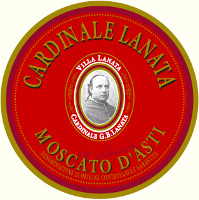
|
|
Moscato d'Asti Cardinale Lanata 2015 |
|
| Villa Lanata (Piedmont, Italy) | |
 Moscato Bianco Moscato Bianco | |
| Price: € 10.40 | Score: |
 Pale greenish yellow and nuances of greenish yellow, very transparent. Pale greenish yellow and nuances of greenish yellow, very transparent. Clean and pleasing, starts with hints of grape, peach and pear followed
by aromas of apple, sage and lychee. Clean and pleasing, starts with hints of grape, peach and pear followed
by aromas of apple, sage and lychee.
 Sweet and crisp attack, however balanced by alcohol, light body. Sweet and crisp attack, however balanced by alcohol, light body. Pretty persistent finish with flavors of grape, peach and apple. Pretty persistent finish with flavors of grape, peach and apple. Produced in closed tank. Produced in closed tank. |
|
 Fruit desserts, Semifreddo Fruit desserts, Semifreddo |
|
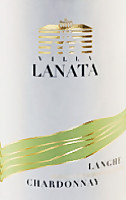
|
|
Langhe Chardonnay 2014 |
|
| Villa Lanata (Piedmont, Italy) | |
 Chardonnay Chardonnay | |
| Price: € 8.50 | Score: |
 Giallo paglierino brillante e sfumature giallo paglierino, molto
trasparente. Giallo paglierino brillante e sfumature giallo paglierino, molto
trasparente.
 Intenso, pulito e gradevole, apre con note di banana, mela e acacia
seguite da aromi di pera, biancospino e susina. Intenso, pulito e gradevole, apre con note di banana, mela e acacia
seguite da aromi di pera, biancospino e susina.
 Attacco fresco e comunque equilibrato dall'alcol, buon corpo, sapori
intensi, piacevole morbidezza. Attacco fresco e comunque equilibrato dall'alcol, buon corpo, sapori
intensi, piacevole morbidezza.
 Finale persistente con ricordi di banana, mela e susina. Finale persistente con ricordi di banana, mela e susina. 6 mesi in vasche d'acciaio. 6 mesi in vasche d'acciaio. |
|
 Pasta and risotto with fish, Sauteed white meat, Sauteed fish, Eggs Pasta and risotto with fish, Sauteed white meat, Sauteed fish, Eggs |
|
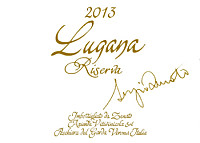
|
|
Lugana Riserva Sergio Zenato 2013 |
|
| Zenato (Lombardy, Italy) | |
 Trebbiano di Lugana Trebbiano di Lugana | |
| Price: € 21.00 | Score: |
 Brilliant golden yellow and nuances of straw yellow, very transparent. Brilliant golden yellow and nuances of straw yellow, very transparent. Intense, clean, pleasing, refined and elegant, starts with hints of
plum, apple and hawthorn followed by aromas of ripe peach, honey, medlar,
vanilla, flint, citrus fruits, broom, pear jam and almond. Intense, clean, pleasing, refined and elegant, starts with hints of
plum, apple and hawthorn followed by aromas of ripe peach, honey, medlar,
vanilla, flint, citrus fruits, broom, pear jam and almond.
 Crisp attack and however balanced by alcohol, full body, intense
flavors, pleasing roundness. Crisp attack and however balanced by alcohol, full body, intense
flavors, pleasing roundness.
 Persistent finish with flavors of apple, plum and medlar. Persistent finish with flavors of apple, plum and medlar. 6 months in cask, 12 months in bottle. 6 months in cask, 12 months in bottle. |
|
 Roasted white meat, Roasted fish, Stuffed pasta, Cheese Roasted white meat, Roasted fish, Stuffed pasta, Cheese |
|
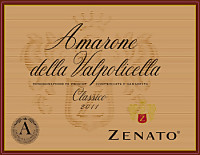
|
|
Amarone della Valpolicella Classico 2011 |
|
| Zenato (Veneto, Italy) | |
 Corvina (80%), Rondinella (10%), Oseleta (10%) Corvina (80%), Rondinella (10%), Oseleta (10%) | |
| Price: € 33.00 | Score: |
 Intense ruby red and nuances of garnet red, little transparency. Intense ruby red and nuances of garnet red, little transparency. Intense, clean, pleasing, refined and elegant, starts with hints of
blackberry, plum and dried violet followed by aromas of blueberry, vanilla,
cocoa, tobacco, mace, cinnamon, leather, nail polish and menthol. Intense, clean, pleasing, refined and elegant, starts with hints of
blackberry, plum and dried violet followed by aromas of blueberry, vanilla,
cocoa, tobacco, mace, cinnamon, leather, nail polish and menthol.
 Tannic attack and however balanced by alcohol, full body, intense
flavors, pleasing roundness. Tannic attack and however balanced by alcohol, full body, intense
flavors, pleasing roundness.
 Persistent finish with flavors of blackberry, plum and blueberry. Persistent finish with flavors of blackberry, plum and blueberry. At least 36 months in cask. At least 36 months in cask. |
|
 Game, Stewed and braised meat, Roasted meat, Hard cheese Game, Stewed and braised meat, Roasted meat, Hard cheese |
|
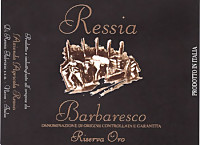
|
|
Barbaresco Canova Riserva Oro 2010 |
|
| Ressia (Piedmont, Italy) | |
 Nebbiolo Nebbiolo | |
| Price: € 50.00 | Score: |
 Brilliant ruby red and nuances of brick red, moderate transparency. Brilliant ruby red and nuances of brick red, moderate transparency. Intense, clean, pleasing, refined and elegant, starts with hints of
cherry, plum and violet followed by aromas of raspberry, dried rose,
vanilla, tobacco, cocoa, leather, cinnamon, mace and menthol. Intense, clean, pleasing, refined and elegant, starts with hints of
cherry, plum and violet followed by aromas of raspberry, dried rose,
vanilla, tobacco, cocoa, leather, cinnamon, mace and menthol.
 Tannic attack and however balanced by alcohol, full body, intense
flavors, pleasing crispness and roundness. Tannic attack and however balanced by alcohol, full body, intense
flavors, pleasing crispness and roundness.
 Persistent finish with flavors of cherry, plum and raspberry. Persistent finish with flavors of cherry, plum and raspberry. 5 years in cask. 5 years in cask. |
|
 Game, Stewed and braised meat, Roasted meat, Hard cheese Game, Stewed and braised meat, Roasted meat, Hard cheese |
|
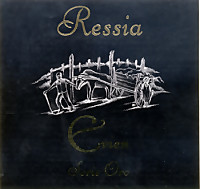
|
|
Evien Oro 2013 |
|
| Ressia (Piedmont, Italy) | |
 Moscato Bianco Moscato Bianco | |
| Price: € 18.00 | Score: |
 Intense golden yellow and nuances of golden yellow, very transparent. Intense golden yellow and nuances of golden yellow, very transparent. Intense, clean, pleasing, refined and elegant, starts with hints of
grape, apple and lychee followed by aromas of peach, citrus fruits,
apricot, candied fruits, quince, white rose, sage and broom. Intense, clean, pleasing, refined and elegant, starts with hints of
grape, apple and lychee followed by aromas of peach, citrus fruits,
apricot, candied fruits, quince, white rose, sage and broom.
 Crisp attack and however balanced by alcohol, full body, intense
flavors, pleasing roundness. Crisp attack and however balanced by alcohol, full body, intense
flavors, pleasing roundness.
 Persistent finish with flavors of grape, citrus fruits and honey. Persistent finish with flavors of grape, citrus fruits and honey. 24 months in acacia casks, 3 months in steel tanks. 24 months in acacia casks, 3 months in steel tanks. |
|
 Roasted white meat, Stewed and broiled crustaceans, Stuffed pasta, Hard cheese Roasted white meat, Stewed and broiled crustaceans, Stuffed pasta, Hard cheese |
|
News |
|
In this section are published news and information about events concerning the world of wine and food. Whoever is interested in publishing this kind of information can send us a mail to our address.
|
AquavitaeReview of Grappa, Distillates and Brandy |
|
|
||||||||||||
Wine Guide ParadeMay 2016
|
| |||||||
Privacy Policy | |||||||


| Copyright © 2002-2024 Antonello Biancalana, DiWineTaste - All rights reserved |
| All rights reserved under international copyright conventions. No part of this publication and of this WEB site may be
reproduced or utilized in any form or by any means, electronic or mechanical, without permission in writing from DiWineTaste. |